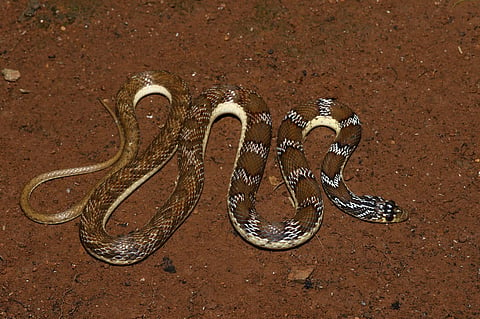

BHUBANESWAR: A group of researchers has discovered a new species of racer snake from Tamil Nadu and made a major taxonomic amendment for two widely distributed Indian snake species. The new species is named after late herpetologist Naveen Joseph.
The new species, Platyceps josephi, is a nonvenomous colubrid medium sized (maximum total length 951 mm) snake that can be seen in the open grasslands with rocky and scrub habitats.
The researchers working at Natural History Museum, London, Ashoka Trust for Research in Ecology and the Environment (ATREE), Zoological Survey of India, Don Bosco University, Assam, Indian Herpetological Society, Pune, and Museum für Naturkunde Berlin, Germany, found that the banded racer snakes found in the southeastern part of peninsular India are morphologically and genetically distinct
from the rest of the racer populations.
Platyceps josephi shows most similarities with its sister taxon Platyceps plinii, which is widespread over the Indian subcontinent, with regard to pholidosis and colour pattern but can be distinguished by its lower number of mid-body dorsal scale rows. It also differs from P plinii in variation of mitochondrial DNA sequences.
“The uncommon Platyceps josephi found across central and southern Tamil Nadu is a diurnal snake, terrestrial and swift in locomotion. The new species has been named after herpetologist Naveen Joseph, who had brought it first to our notice,” said V Deepak, the lead author of the study.
The snake species studied was spotted from one protected area (Megamalai) in its known range. The species faces a number of threats across its distributional range, including habitat destruction, because the grasslands in southern Tamil Nadu are being actively converted into plantations, farmlands and urbanisation.
“Road traffic is another important threat to P josephi. Three out of the seven specimens collected for the study were road-killed and six other uncollected road-killed specimens were observed from various parts of Tamil Nadu between 2017 and 2020,” said Surya Narayanan, an associate from ATREE, Bengaluru.
The snakes which got replacement names are the banded racer and the Anamallai wolf snake. While the banded racer is a widespread terrestrial colubrid snake inhabiting subtropical and tropical dry deciduous/thorn forests of South Asia from Pakistan to India, the Anamallai wolf snake is distributed in southern peninsular India and Sri Lanka.
“It took many years to study the taxonomic history of the banded racer. The study included all available literature and a wide range of samples from Indian museums as well as western museums,” said Deepak.
During the early nineteenth century, many species of snakes were described based on the paintings of Patrick Russell, a Scottish surgeon and naturalist, who extensively studied snakes and their venom in India.
Russell -- the Father of Indian Ophiology -- was in Visakhapatnam in the late 1700s and his catalogue of snakes largely consisted of snakes from peninsular India. He had also recorded local names for many species.
When the researchers started working on the banded racer, they stumbled upon the wrong nomenclature of the species. A closer look at the literature revealed that both species were misidentified since 1856 because of a single mistake which got carried forward.
“The present study resolves these issues. We have reviewed over 400 pieces of literature and 100 specimens which are now stored in museums across different countries in Europe and the US. The investigation led us to allocate the correct scientific names of the banded racer, which is now called Platyceps plinii and the wolf snake, which is called Lycodon fasciolatus,” said Pratyush P Mohapatra of the Zoological Survey of India working in one of its regional centres at Jabalpur.
The study has been published in the peer-reviewed journal Vertebrate Zoology.